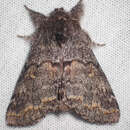Conservation Status
provided by University of Alberta Museums
A common, widespread species. No concerns.
- license
- cc-by-nc
- copyright
- University of Alberta Museums
Cyclicity
provided by University of Alberta Museums
One of the first moths to emerge in the spring, from early May - mid July, depending on elevation.
- license
- cc-by-nc
- copyright
- University of Alberta Museums
Distribution
provided by University of Alberta Museums
A western mountain species, occurring from Vancouver Island east to the Alberta foothills. In Alberta, it occurs throughout the mountains, east to about Beavermines, Seebe, Nordegg and Pocahontas. The only area where it has been collected east of the mountains is in the northern Peace River area, near Dixonville, where it was taken in the same trap with Gluphisia lintneri.
- license
- cc-by-nc
- copyright
- University of Alberta Museums
General Description
provided by University of Alberta Museums
A fairly large (3.5 - 4.5 cm. wingspan) broad-winged moth. The forewing is grey, crossed with diffuse lines of black and yellow-brown. The hindwing is light grey with two faint darker bands, which become black and prominent in the anal angle. The largest and darkest of the four species of Gluphisia. G. severa is similar to G. lintneri, which it meets and flies with in the foothills. Severa is larger, somewhat darker, and lacks the large, diffuse but prominent dark patch along the inner half of the lower edge of the forewing. This is replaced in severa by a short, dark bar or spot at the bottom of the antemedian line. Questionable specimens may require dissection for positive identification. In severa males, the lobes of the uncus are narrow, subacute and deeply excavated; the lobes of the transtilla are broad, short and acute; and the juxta is broad, widely excavated, and has acute, produced lobes. Females are a bit larger, darker and more strongly banded than males. Male severa also bear a close resemblance to the Geometrid moth Lycia ursaria, which flies at the same time. L. ursaria is grey and lacks the prominent yellow-browns of severa.
- license
- cc-by-nc
- copyright
- University of Alberta Museums
Habitat
provided by University of Alberta Museums
Mixedwood and deciduous forest in the mountains and along the western edge of the foothills.
- license
- cc-by-nc
- copyright
- University of Alberta Museums
Life Cycle
provided by University of Alberta Museums
The Banded Pebble is one of the first moths to emerge in the spring. Adults are nocturnal and come readily to light. The larvae are apparently solitary defoliators. They overwinter in the pupal stage.
- license
- cc-by-nc
- copyright
- University of Alberta Museums
Trophic Strategy
provided by University of Alberta Museums
No Alberta data available. In BC, larvae have been found on White birch (Betula papyrifera), cherry (Prunus), willow (Salix), and Trembling aspen (Populus tremuloides). (Prentice et al, 1962).
- license
- cc-by-nc
- copyright
- University of Alberta Museums
Gluphisia severa
provided by wikipedia EN
- license
- cc-by-sa-3.0
- copyright
- Wikipedia authors and editors
Gluphisia severa: Brief Summary
provided by wikipedia EN
Gluphisia severa, the banded pebble, is a species of moth in the family Notodontidae (the prominents). It was first described by Henry Edwards in 1886 and it is found in North America.
The MONA or Hodges number for Gluphisia severa is 7935.
- license
- cc-by-sa-3.0
- copyright
- Wikipedia authors and editors

